Acer Aspire One
Many people are unaware of just how big a player Acer is in the computer industry. Acer has been in business since 1976 and during this time has acquired the likes of Gateway, Packard Bell and eMachines. Acer's maiden voyage into the netbook mix came in July 2008 with the release of the Acer Aspire One. The Aspire One is the smallest netbook in our roundup but aims to prove that size doesn't always matter.
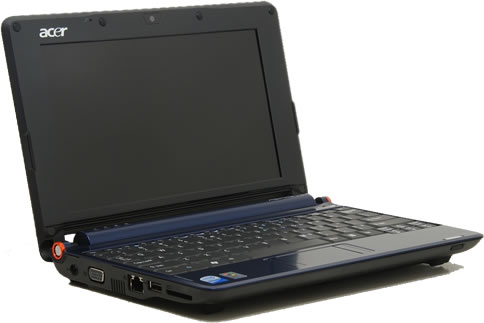
Included in the retail package is the Aspire One, 3-Cell Battery, AC Power Adapter, Carrying Case, Warranty Guide, International Travelers Warranty Guide, Quick and Full User Guides. As you can see on the picture above, the Aspire One we tested is blue which seems to be the most popular color, but it's also available in pink, brown or white.
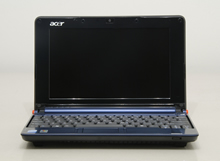
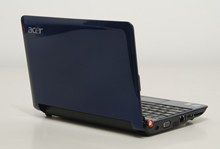
The Acer Aspire One measures 9.8" x 6.7" x 1.1" with a total weight of only 2.3 pounds. The Aspire One is outfitted with an 8.9" WSVGA display capable of 1024 x 600 resolution, powered by a 1.6 GHz Intel Atom Processor, 1GB of memory and a 160GB hard drive.
The blue metallic paint on the Aspire One covers the outside lid and the bezel around the keyboard. The lid is finished with clear coat for a protective shine, while the inside is more of a flat blue.
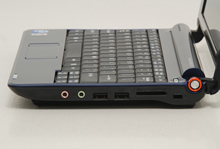
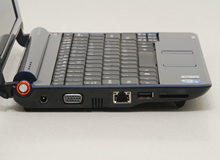
The left side of the Aspire One has a SD card slot, USB 2.0 port, network jack, VGA out and AC power jack. On the opposite side we find microphone and headphone jacks, two additional USB 2.0 ports, multi-card reader (MMC/MS/MS Pro/xD) and a security lock slot.
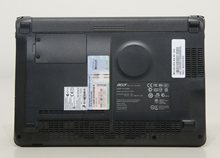
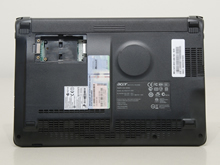
Underneath we find four rubber feet, two battery release sliders and plenty of ventilation slots. The removable expansion bay does not give you access to the memory and hard drive, but rather an empty bay. This is a mini-PCIe bay and rumor has it that Acer will be releasing a cell-based 3G card for this slot eventually. There is a slot under the battery for a SIM card and some modders have already taken advantage of this by adding HSPDA modems for wireless cellular connectivity.
To reach the memory and hard drive, you must remove the entire backside of the unit. Much like the Lenovo S10, this unit also has a sub-par memory configuration: 512 MB fixed onboard and a 512 MB occupying the single expansion slot.
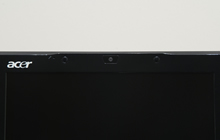
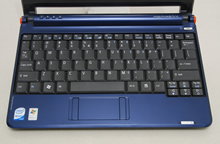
Webcams are a standard feature on netbooks and the Aspire One is no different. Centered above the screen is Acer's Crystal Eye webcam with the microphone just to the left of it.
Despite having the least horizontal space of the bunch to work with, Acer has done a really good job with the keyboard layout. The Control and Function keys are in the "correct" place and nearly every other button is of an acceptable size, although I wish the Backspace key was a bit wider.
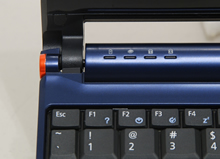
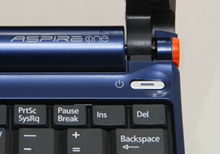
Due to its small size, the Aspire One does have to make sacrifices and unfortunately, they are pretty big ones in my book. The touchpad works well and has the same pinch / pull feature as the S10. But, it is not without fault. The pad is pretty small and the mouse click buttons had to be relocated to either side of the pad. I can't tell you how many times I mistakenly reached below the touchpad for the buttons. In fact, I never got used to this unusual button placement during testing.
Finally I must again come back to the small size and note that the area that your wrists rest on when typing is simply too small. When measured, this area is nearly ½" less than every other netbook here today. As a result, my wrists hung off the edge of the Aspire One when typing which was less than comfortable.
The Aspire One is the only netbook in our roundup to incorporate a glossy screen and one of two to use a smaller 8.9" screen size. It should be noted that screen size wasn't an issue during use because it operates at the same resolution as the larger 10" screens. Acer has also framed the display with a nice solid bezel so it doesn't look out of place. Due to the glossy screen, reflections and glare become apparent when used in well-lighted environments. However, the screen itself earns best in show honors and easily outclasses the others in terms of clarity and color depth.
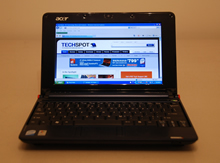
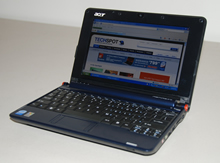
The 160GB hard drive in the Aspire One is the only one of the bunch that isn't split into multiple partitions. I prefer storing my music and photos on a different partition from the OS, and backing up is also less of a pain when you have a secondary partition.
Acer has included a modest software suite comprised of a 60-day Microsoft Office Home and Student 2007 trial, McAfee Security Center, InterVideo WinDVD (despite the lack of optical drive), Acer eRecovery Management, Google Desktop and Microsoft Works. McAfee SecurityCenter is a pretty decent antivirus and firewall application and I even use it on my personal system. I removed Google Desktop as I noticed it was eating up a lot of CPU processing power, which on the Intel Atom is already limited. Acer eRecovery Management allows you to quickly and easily restore the system to factory default and reinstall original applications and drivers.
The Aspire One's audio system was comparable to that found on the Lenovo S10 in terms of sound quality, clarity and loudness, although the dual speakers are mounted on the bottom of the netbook and fire downward rather than facing the user directly like on the S10. Audio quality was a little tinny but certainly not a deal breaker. Either way, both are superior to those used in the Slice.
The 3-cell battery that shipped with our Aspire One provided 2 hours and 28 minutes of power at half screen brightness and Wi-Fi disabled while sitting idle at the Windows desktop. This was good for 2nd place in the 3-cell battery category.
Pros: Small and Lightweight, Best Screen Quality, Good Keyboard Layout, Expansion Bay for Future 3G Card, Large Capacity Hard Drive
Cons: Small Screen, Glossy Screen, Bad Placement of Mouse Click Buttons, Small Area For Your Wrist, Memory Only Expandable To 1.5GB

